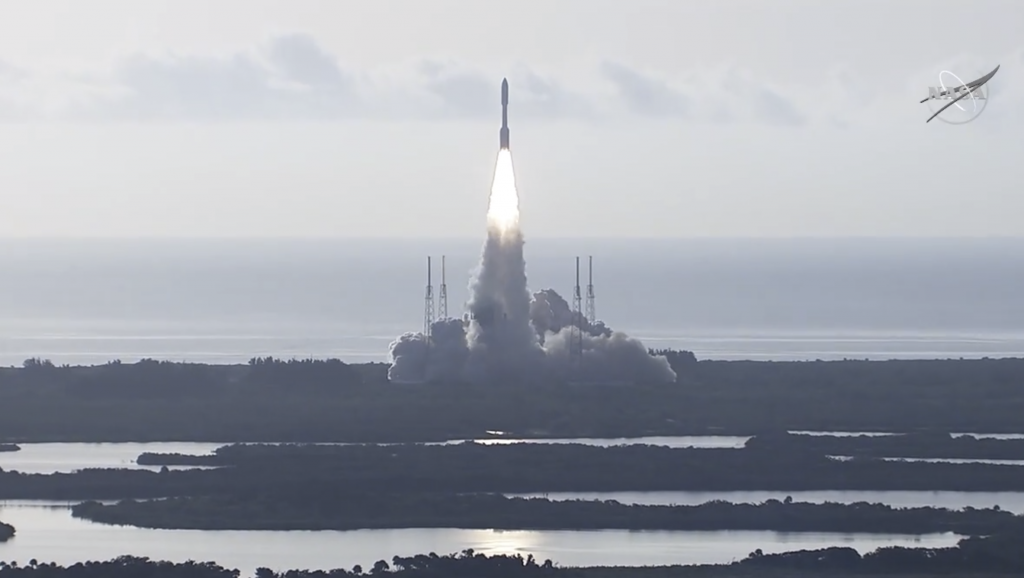Launch of the Mars 2020 mission – The Perseverance rover with the SuperCam instrument on board is on its way to Mars!
Thursday, July 30, 2020, successful launch of the Mars 2020 mission from Cape Canaveral, Florida! Aboard an Atlas V launcher, the Perseverance rover that carries the Franco-American SuperCam instrument begins its great journey to the Red Planet. Landing scheduled for February 18, 2021.

About four billion years ago, the Earth and Mars, much more similar than today, both had a dense atmosphere, liquid water and a large-scale magnetic field. This similarity leads to the fundamental question that drives exobiologists: “If life developed on Earth at that time, could a form of life have also appeared on Mars?
Perseverance will explore ancient environments of the planet Mars in order to decipher its geological history and better characterize its habitability. It will search for traces of past life by detecting possible bio signatures. Its mission is also to prepare the human exploration of Mars. The rover is designed to collect samples that will be recovered and brought back to Earth thanks to the joint missions of the United States and Europe, planned within the next ten years (MSR, Mars Sample Return).
Perseverance carries seven instruments, a sample collection and conditioning system and the small “helicopter” drone, Ingenuity. The French contribution concerns the SuperCam instrument, a much improved version of ChemCam, which has already been operating aboard the Curiosity rover on Mars since August 6, 2012.
SuperCam will study the chemistry and mineralogy of the rocks and soils of Mars, as well as the composition of its atmosphere. It is a bit like the “Swiss Army knife” of the mission scientists. It performs five different types of analysis: one measurement of elemental chemical composition, two molecular measurements (the way atoms are bound together and the arrangement of molecules within minerals), an imager to take pictures of the targets that are being analyzed, and finally a microphone. SuperCam carries many complex subsystems, including a power laser made in France. The instrument will help scientists in their search for early and fossilized signs of microbial life on the Red Planet.
On February 18, 2021, Perseverance will land in the Jezero crater, an impact basin 45 kilometers in diameter. This crater is home to an ancient river delta that flowed into a lake 3.5 billion years ago. The ancient lake-delta system offers the opportunity to collect samples from a wide variety of rocks and minerals, especially carbonates that can preserve fossil traces of ancient life.
For Jean-Yves Le Gall, President of the CNES, “Once again, France is on its way to Mars alongside the United States, of which it is the privileged partner. The work that Perseverance will undertake is in line with the discoveries made by previous Martian missions, it will teach us more and more about our history, our environment and future prospects. Once again, I would like to thank all the teams that contributed to this success as well as NASA for the confidence that year after year, mission after mission, it renews in CNES. I look forward to meeting everyone on February 18, 2021 for the landing on the surface of Mars. A new page in the history of Mars exploration is being written and CNES is part of it. »
For Antoine Petit, Chairman and CEO of the CNRS, “This successful departure to the planet Mars was a very emotional moment, shared with all the men and women involved in the realization of this scientific project and with the general public who are still as passionate about our research. Thanks to NASA and CNES, scientists from CNRS and its partners are returning to the Red Planet with renewed ambition. Perseverance, the first link towards a return of Martian samples in the 2030s, is above all a great international human adventure as only science and the quest for knowledge can offer us. »
NASA is relying on Caltech/JPL for the development of the Mars 2020 mission. SuperCam is jointly developed by LANL (Los Alamos National Laboratory, USA) and a consortium of French laboratories under the scientific direction of IRAP (CNRS / CNES / University Toulouse III Paul Sabatier, Toulouse, France), with a contribution from the University of Valladolid (Valladolid, Spain). CNES is responsible, vis-à-vis NASA, for the French contribution to SuperCam. CNES, CNRS and many universities have provided human resources for the construction of this instrument. The French team contributing to SuperCam will participate daily in the scientific operations and the instrument will be operated alternately from the LANL and the control center installed at CNES in Toulouse (FOCSE Mars 2020).
In France, many laboratories, attached to CNRS and its partners, as well as institutions have brought their scientific expertise and contributed to the construction of SuperCam: IRAP (Toulouse), LESIA (Meudon), LAB (Bordeaux), LATMOS (Guyancourt), OMP (Toulouse) and IAS (Orsay)1 , ISAE-SUPAERO (Toulouse) and CNES.
Note
- Institut de recherche en astrophysique et planétologie (IRAP, CNRS/Université de Toulouse III – Paul Sabatier/CNES) ; le Laboratoire d’études spatiales et d’instrumentation en astrophysique (LESIA, Observatoire de Paris-PSL/CNRS/SU/Université de Paris) ; le Laboratoire d’astrophysique de Bordeaux (LAB, CNRS/Université de Bordeaux) ; le Laboratoire « atmosphères et observations spatiales » (LATMOS, CNRS/SU/UVSQ) ; l’Observatoire Midi-Pyrénées (OMP, CNRS/IRD/Météo-France/Université de Toulouse III – Paul Sabatier) ; l’Institut d’astrophysique spatiale (IAS, CNRS/Université Paris-Saclay).
IRAP Contact
- Sylvestre Maurice, sylvestre.maurice@irap.omp.eu






